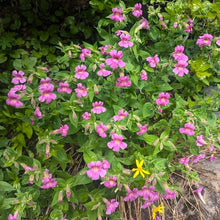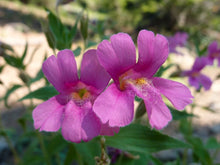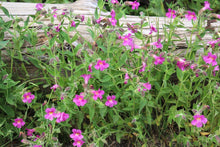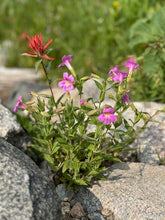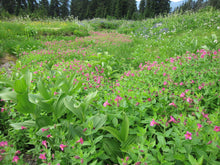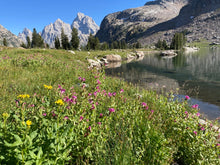
Erythranthe lewisii (formerly Mimulus lewisii)
Purple monkeyflower (aka pink monkeyflower or Lewis' monkeyflower) is a perennial wildflower that typically grows as a compact, clump-forming species with soft, oval leaves and stems that typically range from 12 to 24 inches in height. In spring, it bursts into a spectacular display of vibrant, funnel-shaped pinkish-purple flowers that are adored by hummingbirds. Throughout summer, its blossoms persist, adding a cheerful splash of color to gardens and landscapes, especially in cooler climates. This plant thrives in moist, well-drained soils near streams, meadows, and wetland areas, offering valuable habitat and nourishment for pollinators and wildlife.
- Plant type/canopy layer: deciduous, perennial, herbaceous plant
- Size at maturity: up to 36” tall, but usually shorter, about 12" wide
- Light requirements: full sun
- Moisture requirements: moist to wet soil, may require moderate summer water
- Bloom time: May - Aug
- Growth rate/ease: medium growth rate, easy to grow in the right conditions
- Wildlife support: flowers attract and provide nectar for hummingbirds, adult butterflies, bees and other insect pollinators; fruits/seeds are food for birds; overall plant is a host and larval food source for caterpillars/larvae of several species of native butterflies and moths
- Native habitat/range: grows along moist riverbanks, wet-meadows and forested, alpine and subalpine areas from Alaska to California and east to Montana, Wyoming, and Colorado - specifically common on both sides of the Cascade crest throughout the Pacific Northwest. Portland Plant List - no (though there are documented occurrences in east Multnomah County)
- Special features & uses: hummingbird and butterfly favorite; deer resistant; landscape uses include sunny pollinator gardens, rain gardens and bogs
Gardening with Purple Monkeyflower: To successfully garden with this species, it’s important to choose a planting site that most closely replicates its native habitat; such as a moist, well-drained area in partial to full sun. It will thrive in areas with regular water, so be sure its getting near-consistent moisture, either from rain or irrigation (during the dry summer months), while ensuring good drainage to prevent root rot. To encourage healthy growth and abundant blooms, amend the soil with organic matter, and avoid heavy fertilization, since, like many native plants, it is adapted to nutrient-poor environments. This species can tolerate a range of temperatures, making it ideal for Oregon’s diverse climates, but it will perform best in cooler coastal or mountain gardens. Additionally, since this plant attracts bees and hummingbirds, it can be incorporated into pollinator-friendly landscapes or garden beds alongside other native plants that support local wildlife.
Photo Credit 1 (many blooms): © Ryan Sorrells, some rights reserved (CC-BY)
Photo Credit 2 (blooms close-up): Nikkie West, Sparrowhawk Native Plants
Photo Credit 3 (with log): © Gabbie Byers, some rights reserved (CC-BY)
Photo Credit 4 (with paintbrush): © Whitney Brook Matson, some rights reserved (CC-BY)
Photo Credit 5 (meadow): © Timothy McNitt, some rights reserved (CC-BY)
Photo Credit 6 (alpine lake): © Loren Cassin Sackett, some rights reserved (CC-BY)






